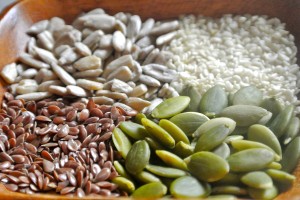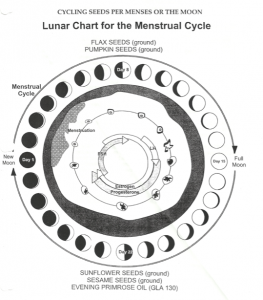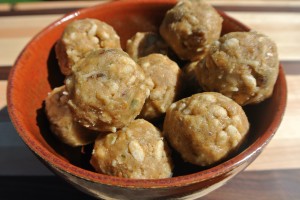
Seed cycling is a natural way to help balance and support your the hormonal shifts that happen during your menstrual cycle.
Seed cycling involves rotating certain seeds in your diet to best support the hormonal phases of your menstrual cycle. This is because seeds contain nutrients and oils to help with the production and metabolism of the hormones. The four seeds used are pumpkin & flax seeds, and sunflower & sesame seeds. The pumpkin & flax seeds are taken together during the first half of your cycle, and the sunflower & sesame seeds are taken together during the last half of your cycle. Ideally, we would menstruate with the lunar cycle, where we would have 28 day cycles, ovulating on the Full Moon and menstruating on the New/Dark Moon. This is optimal, however many women have cycles that are shorter or longer than 28 days. This is why it’s so important to become aware of your body’s rhythms and signals, and to support your cycle through its different phases.
To get started on Seed Cycling, here are a few important things to know about your cycle:
Follicular phase: Day 1 is the first day of menstruation. This begins the follicular phase, which is when the follicle grows and matures. The follicular phase generally lasts around 14-18 days, however this varies among women and is influenced by stress, travel, diet, exercise, and other lifestyle habits. During this phase, you want to support healthy estrogen levels, which is the main hormone released by the ovaries during this time. The follicular phase ends at ovulation.
Eat 1 Tbsp each pumpkin & flax seeds – organic, raw & ground – each day. Pumpkin & flax seeds supports the estrogenic phase of the cycle (menses to ovulation) by providing omega 3’s, fiber & lignans, which help produce & metabolize estrogens.
Luteal phase: This phase begins the day after ovulation, and lasts around 14 days. There is not a whole lot of variation in this phase because the released ovum has a finite life span. During this phase the ovaries release progesterone, which makes the uterine lining ‘juicy’ and prepares it for implantation, as in pregnancy. However if pregnancy is not achieved, progesterone levels drop at the end of this phase, signalling the release of estrogen and subsequent shedding of the uterine lining (menstruation), which starts you back at Day 1.
Eat 1 Tbsp each sesame & sunflower seeds – organic, raw & ground – each day. Sesame & sunflower seeds supports the progestogenic phase of the cycle (2nd half of the cycle) by providing omega 6’s, protein, and nutrients to support this phase. Eating organic meats also assist this phase.

This chart shows the seeds to cycle alongside fluctuating hormones and the physiological changes of the ovarian follicle and uterus lining.
You can sprinkle the seeds in a salad, yogurt, smoothie, sandwich, wrap – or on anything you’d like, really… Here is a recipe for a batch of delicious Seed Cycling Snack Balls (aka Lady Balls) for you to try. It’s a tasty way to get your seeds in and enjoy them too. Eat 3-4 snack balls per day to get an adequate amount of seeds to fully benefit from Seed Cycling.
- ½ cup almond, cashew, or peanut butter
- ½ cup pumpkin seed butter (for menses → ovulation) or sunflower seed butter or tahini (for ovulation → menses)
- 3-4 Tbsp maple syrup
- 1 cup organic flax & pumpkin seed, raw & ground (menses → ovulation) 1:1 ratio or 1 cup organic sesame and sunflower seed, raw & ground (ovulation → menses) 1:1 ratio
- ½ cup dried fruit (cranberries, raisins, chopped dates, currants, etc.)
- ½ cup unsweetened medium shred coconut
- ½ cup brown rice cereal (ie. ‘rice krispies’)
- spices of your choice, to taste (ground cinnamon, cocoa powder, ground nutmeg, ginger powder, chopped crystallized ginger chunks, pure vanilla extract, etc.)
- In a small mixing bowl, add nut/seed butter and maple syrup and stir well. Add spices of your choice, or leave it plain and enjoy the maple or honey flavour. Stir well.
- Add ground seeds and stir to combine.
- Gradually, add dried fruit, shredded coconut, and brown rice cereal and stir until evenly distributed.
- Use your Tablespoon measure to scoop up mixture and form into balls.
- Place in a glass container and store in the freezer for best texture.
- Enjoy!

What are the western nutrition information and the energetics of these treats?
What sort of nutrition information are you looking for? Typically, we are more concerned with the products being sourced from organic & fresh products, and that the foods we recommend are nutrient dense, but otherwise we don’t usually look into the caloric, vitamin or mineral content of a recipe, unless it boasts a significant amount of these things (such as in our Gluten-free protein bars http://naturopathicbynature.com/gluten-free-chocolate-protein-bar-dairy-free/).
And I feel that the energetics are in congruence with the changing energies of the menstrual cycle, which would be a very individual experience.
Do you have a nutritional value to the balls? I would like to know only to calculate in my keto diet, where carbs and protein and fats are important. Thank you.
That is important information to have. Unfortunately, we don’t currently have the nutritional value. We apologize for that. But we can work on it & post the information when it is available.
Is this 1 cup ground or 1 cup then grind for the seeds
Measure 1 cup of ground seeds.
Hi! I’m wondering how I could adjust the recipe to make it so one ball was the adequate amount of seeds to reaps the full benefits. Thank you for this recipe!
Hi Skylar,
I think that you would have to alter the recipe by rolling the recipe into 6-7 balls in order to only eat one ball per day to reap the benefits.
Let me know how it goes!